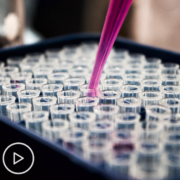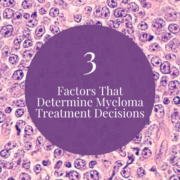Minimal Residual Disease (MRD): What Does it Mean for You?
Minimal Residual Disease (MRD): What Does it Mean for You? from Patient Empowerment Network on Vimeo.
Dr. Matthew Davids defines the term minimal residual disease (MRD) and explains its role in managing chronic lymphocytic leukemia (CLL).
Dr. Matthew Davids is the Associate Director of the CLL Center at Dana-Farber Cancer Institute. More about this expert.
See More From The Path to CLL Empowerment
Related Resources

|

|

|
Transcript:
Dr. Matthew Davids
So, one term that patients often come across when they’re looking online that they might not know exactly what it means is so-called MRD. This stands for minimal residual disease.
And MRD is increasingly becoming an important endpoint in our trials, meaning that it’s a test that we rely on to try to make decisions about treatment in the trials. And we’re hoping that this will be a strategy that we can eventually use in regular clinical practice.
So, what is MRD? Basically, MRD is a way to look, at a very, very molecular level, at tiny, tiny amounts of the disease. And this a feature of the fact that we have very effective treatments for CLL, and so we can give various treatments, whether it’s chemoimmunotherapy or drugs like venetoclax, for example. And then we can look under the microscope in, for example, the bone marrow tissue, and we might not see any CLL cells. So, we might call that a complete remission.
But often, there’s still evidence of molecular disease left behind that we can’t see under the microscope, but we can use very sophisticated biological techniques to actually detect what we call MRD. And we find that, if there is MRD present, that patients don’t tend to have as durable of a remission compared to when MRD is so-called undetectable.
So, it’s a very important term to understand. When patients get to an undetectable MRD state, that’s a very good thing. It means that they’re likely to have a very long response to whatever therapy they had. But you also have to remember that MRD itself has its limits of what it can detect. And so, just being undetectable for MRD does not mean that you’re necessarily cured of the CLL.
And there are patients who have undetectable MRD who later do have a recurrence of the CLL. But it does help us guide the treatment in terms of knowing that patients are in a good remission, that they may be able to stop the treatment that they’re on and enjoy a long response without the need for ongoing treatment.
But eventually, for most CLL patients, the disease will come back. And we can detect that sometimes with this MRD test as well. And that’s an interesting research question ongoing as to whether we should intervene at that point to restart therapy when we first see the MRD test become positive again. And hopefully, that’s something that we’ll continue to learn about as we further explore that question in clinical trials.










